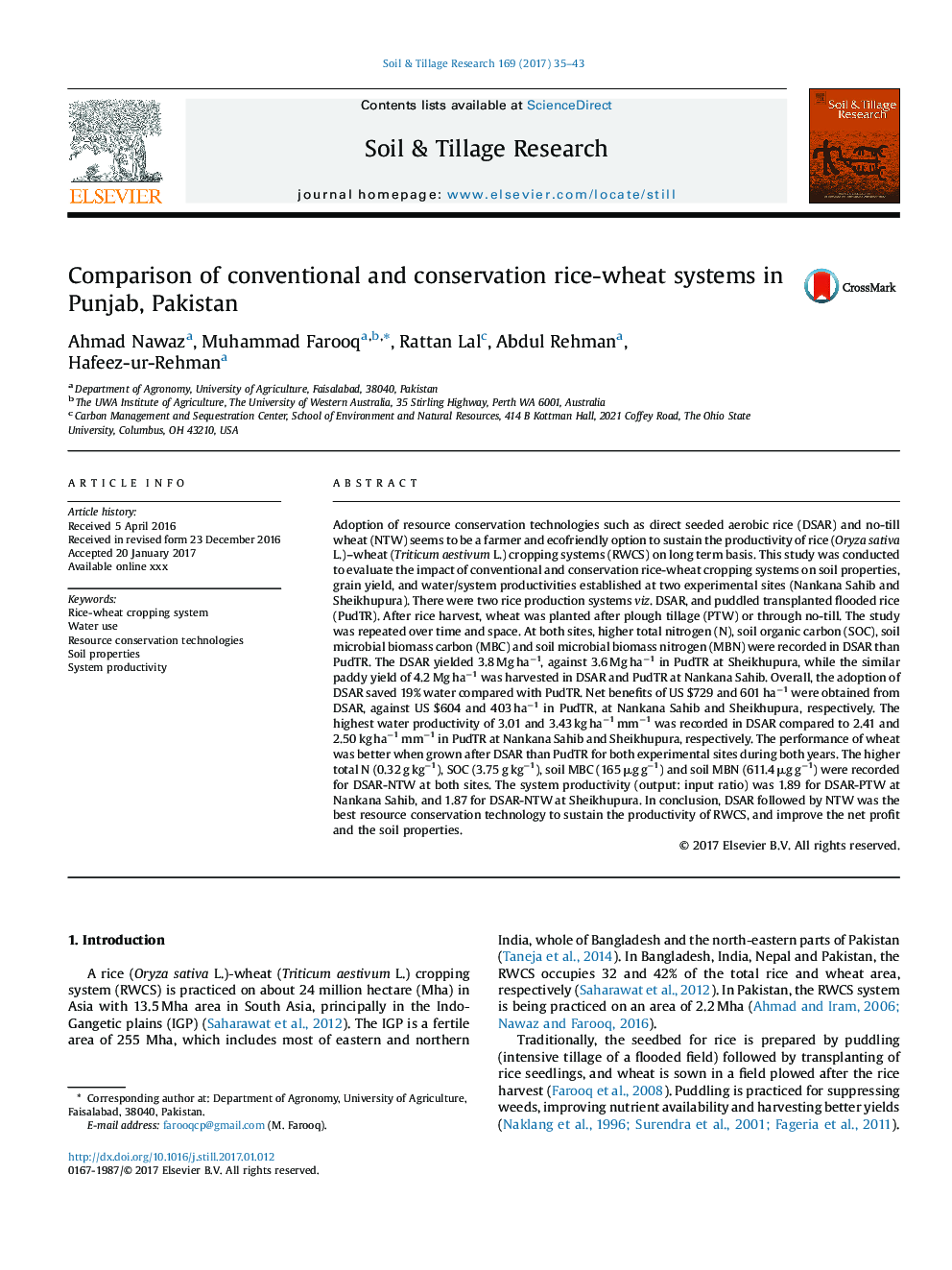| کد مقاله | کد نشریه | سال انتشار | مقاله انگلیسی | نسخه تمام متن |
|---|---|---|---|---|
| 4927572 | 1431834 | 2017 | 9 صفحه PDF | دانلود رایگان |
عنوان انگلیسی مقاله ISI
Comparison of conventional and conservation rice-wheat systems in Punjab, Pakistan
ترجمه فارسی عنوان
مقایسه سیستم های گندم معمولی و حفاظتی در پنجاب پاکستان
دانلود مقاله + سفارش ترجمه
دانلود مقاله ISI انگلیسی
رایگان برای ایرانیان
کلمات کلیدی
سیستم برداشت گندم، استفاده از آب، فن آوری های حفاظت منابع خواص خاک، بهره وری سیستم،
موضوعات مرتبط
مهندسی و علوم پایه
مهندسی انرژی
انرژی های تجدید پذیر، توسعه پایدار و محیط زیست
چکیده انگلیسی
Adoption of resource conservation technologies such as direct seeded aerobic rice (DSAR) and no-till wheat (NTW) seems to be a farmer and ecofriendly option to sustain the productivity of rice (Oryza sativa L.)-wheat (Triticum aestivum L.) cropping systems (RWCS) on long term basis. This study was conducted to evaluate the impact of conventional and conservation rice-wheat cropping systems on soil properties, grain yield, and water/system productivities established at two experimental sites (Nankana Sahib and Sheikhupura). There were two rice production systems viz. DSAR, and puddled transplanted flooded rice (PudTR). After rice harvest, wheat was planted after plough tillage (PTW) or through no-till. The study was repeated over time and space. At both sites, higher total nitrogen (N), soil organic carbon (SOC), soil microbial biomass carbon (MBC) and soil microbial biomass nitrogen (MBN) were recorded in DSAR than PudTR. The DSAR yielded 3.8 Mg haâ1, against 3.6 Mg haâ1 in PudTR at Sheikhupura, while the similar paddy yield of 4.2 Mg haâ1 was harvested in DSAR and PudTR at Nankana Sahib. Overall, the adoption of DSAR saved 19% water compared with PudTR. Net benefits of US $729 and 601 haâ1 were obtained from DSAR, against US $604 and 403 haâ1 in PudTR, at Nankana Sahib and Sheikhupura, respectively. The highest water productivity of 3.01 and 3.43 kg haâ1 mmâ1 was recorded in DSAR compared to 2.41 and 2.50 kg haâ1 mmâ1 in PudTR at Nankana Sahib and Sheikhupura, respectively. The performance of wheat was better when grown after DSAR than PudTR for both experimental sites during both years. The higher total N (0.32 g kgâ1), SOC (3.75 g kgâ1), soil MBC (165 μg gâ1) and soil MBN (611.4 μg gâ1) were recorded for DSAR-NTW at both sites. The system productivity (output: input ratio) was 1.89 for DSAR-PTW at Nankana Sahib, and 1.87 for DSAR-NTW at Sheikhupura. In conclusion, DSAR followed by NTW was the best resource conservation technology to sustain the productivity of RWCS, and improve the net profit and the soil properties.
ناشر
Database: Elsevier - ScienceDirect (ساینس دایرکت)
Journal: Soil and Tillage Research - Volume 169, June 2017, Pages 35-43
Journal: Soil and Tillage Research - Volume 169, June 2017, Pages 35-43
نویسندگان
Ahmad Nawaz, Muhammad Farooq, Rattan Lal, Abdul Rehman, Hafeez-ur-Rehman Hafeez-ur-Rehman,
